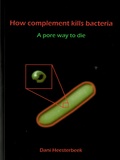How complement kills bacteria

Heesterbeek, Dani
- Promoter:
- Prof.dr. S.H.M. (Suzan) Rooijakkers
- Co-promoter:
- Dr. B.W. (Bart) Bardoel
- Research group:
- Rooijakkers
- Date:
- August 29, 2019
- Time:
- 12:45 h
Summary
When Gram-negative bacteria invade the human body these are immediately recognized by the complement system, a group of proteins that circulate in the blood. The complement system can efficiently kill Gram-negative bacteria via the formation of bactericidal pores, called Membrane Attack Complexes (MACs). Despite decades of research, it remained unknown how these MAC pores disrupt the composite cell envelope of Gram-negative bacteria and what triggers cell death. In addition, the interplay between complement and other antimicrobial factors in clearing infections with Gram-negative bacteria was largely unknown.
This thesis describes the mechanism with which the Membrane Attack Complex kills Gram-negative bacteria. We unraveled that surface-bound C5 convertases are essential to properly insert MAC pores into the bacterial outer membrane. Whereas the purified MAC (C5b-9) can lyse single membrane particles and the bacterial outer membrane, we showed that these pores lack bactericidal activity. In contrast, convertase-generated MAC pores efficiently trigger inner membrane damage and killing. We also found that C5 convertases on a bacterial surface (but not human cells) are stable and can trigger MAC formation for up to 90 minutes. This long-lasting activity can (at least partly) be attributed to properdin, a protein in serum that stabilizes the interaction between C3b and Bb. Furthermore, we describe the dynamics of MAC-dependent outer and inner membrane disruption of Gram-negative bacteria and elucidate that the MAC efficiently damages the outer membrane and, after a delay, also the inner membrane. We show that complement-dependent outer membrane disruption sensitizes bacteria to naturally impermeable antibiotics leading to enhanced killing by these antibiotics. Finally, we found that the MAC also sensitizes Gram-negative bacteria to peptidoglycan-degrading proteins, such as lysozyme, in- and outside neutrophils. This shows how different arms of the immune system work together to efficiently kill and degrade Gram-negative bacteria.